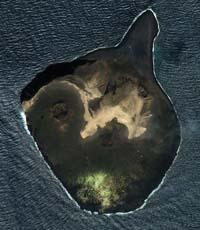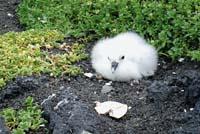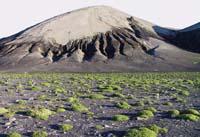Surtsey, a deserted island
2006/11/01 Galarraga Aiestaran, Ana - Elhuyar Zientzia Iturria: Elhuyar aldizkaria

The eruption did not completely calm until 1967, when the island had an area of 2.7 km 2 and the highest peak 173 m high. Since then, wind and waves have strongly eroded the island, so last year only had an area of 1.4 km 2 and one day Surtsey will disappear. According to geologists, this will occur between 100 and 500 years.
In fact, the Sey Vestmannaeyjar is located in the volcanic seabed system, where earthquakes and eruptions are common, but normally, once a eruption is over, there is no more in the same place. Therefore, Surtsey disappears at some point.
However, the island is not eroding as quickly as it was born. In fact, at first the waves and the wind easily dragged the materials thrown by the volcano and they were not completely compacted. But what is now is covered with hard slabs that are not so easy to erode. In addition, chemical reactions have occurred in the starting material that have hardened and compacted the rocks.
Violent childbirth
Time will tell how long Surtsey will last in the future, but his past and present are being exciting for scientists. Geologists have been able to analyze the birth and evolution of a volcanic island, and biologists, among others, have been able to investigate how living beings colonize the island. Undoubtedly, the island is a paradise for scientists.
However, when I was creating, instead of paradise, the island looked like hell. The first signs of the volcano were collected by geologists a week before the eruption began in the seismograph of Reykjavik. Light earthquakes were detected, but they did not know where they were.
Seven days later, some sailors realized the place. On 14 September 1963, the sailors of Islefur II saw a column of black smoke rising from the sea. They approached thinking that a boat could be in the fire and realized it was a rash.

The following week the eruption did not stop and as the material demolished by the volcano accumulated an island was formed. In a few days it had a length of 500 meters and a height of 45 meters.
Thanks to the eruptions, the island grew and compacted. For example, in 1964 the volcano poured numerous slabs that joined and compacted the rocks. But over time volcanic activity has softened and the volcano has been asleep since June 5, 1967.
At that time there were also other major eruptions around Surtsey. Two of them formed islands: SyrtlMA and Jolnir But once the eruption was over, the erosion made both disappear. Geologists closely followed the whole process.
Victory of life
Biologists also showed interest in Surtsey from the beginning. Tell us: In 1965, with still active eruption, the island was declared a nature reserve. Today, only a few scientists have permission to go there.
Biologists have carefully analyzed how living beings have colonized the island. By 1964, for example, there were insects. They were flying insects that came from the nearby islands, accompanied by drafts. Later, the insects arrived in pieces of wood dragged by the water.
The bugs attracted the birds. Dead birds became food for carnivorous insects. By the way, the soil was fertilized, which allowed the growth of the plants. In turn, this benefited the vegetative insects.

As for plants, lichens and mosses first appeared in 1965. Today they are the main plants. In fact, the sandy lands of the island are quite arid, so few species manage to maintain themselves. In total, about 60 species of plants have been detected on the island, which have lasted half. However, in 1998 botanists saw the first bush.
In the implantation of plants, birds have had a great importance: in the extension of seeds, in the fertilization of the soil... The first to nest were the fulmares and martines, three years after the eruption, where eight species now live. For example, since 1986 there have been seagulls. In addition, some migrants also come to the Surtsey.
On the other hand, in the underwater area of the island and in the adjacent sea, biologists have found numerous species: marine herbs, lapas, starfish, seals, orcas...
All these species live in a harsh environment, but at least they do not have to compete with the human species. And the laws of the reservation are very strict. The young island is eroding, but it is well cared for.




